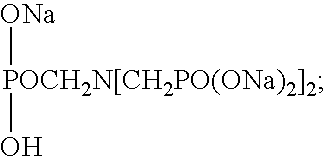Rinse aid composition for use in automatic dishwashing machines, and methods for manufacturing and using
a technology for automatic dishwashing machines and compositions, which is applied in the direction of detergent compositions, anionic surface active compounds, and organic/inorganic per-compound compounding agents, etc., can solve the problems of undesirable hard water spots, glassware, dishes, cutlery washed in automatic dishwashers, and hard water spots that are not dried, so as to reduce the untoward appearance of water spots and the effect of reducing the risk of agglomeration
- Summary
- Abstract
- Description
- Claims
- Application Information
AI Technical Summary
Benefits of technology
Problems solved by technology
Method used
Image
Examples
example 1
[0079]Three controls were prepared. For the first control (A), ceramic tiles were rinsed with 1000 ppm of purchased nanoparticles. For the second control (B), a tile was treated with citric acid. For the third control (C), the tile was untreated. One tile (D) was treated with a composition according to the present invention. That is, 1000 ppm potassium silicate was used to treat the tile. The tile was then treated with citric acid in order to drop the pH to between about 3 and 4. All tiles were then thoroughly rinsed with tap water and allowed to air dry. The contact angle of deionized water was measured using a goniometer. The lower the contact angle of deionized water, the better the wetting of the surface, and the less likely the surface will show water spotting. Results are shown in the table below:
TileTreatmentContact Angle (degrees)A1000 ppm nanoparticles14BCitric acid33CWater32DPotassium silicate / citric11acid
[0080]The results show that tile D, treated according to the inventi...
example 2
[0081]Tiles were treated in varying order to show that it was inconsequential if the tiles were treated with acid first followed by anion or if they were treated with anion followed by acid. Tile E was treated first with citric acid followed by 1000 ppm potassium silicate. Tile F was treated first with 1000 ppm potassium silicate followed by citric acid. Contact angle of water was measured with a goniometer. Results are shown in the table below:
Tile sampleTreatmentContact Angle (degrees)EAcid then anion15FAnion then acid11
example 3
[0082]Tiles were treated with different anionic sources as well as different acid sources. Tile G was treated with 1000 ppm potassium silicate followed by citric acid, Tile H was treated with 1000 ppm aluminum silicate followed citric acid, Tile I was treated with 1000 ppm potassium silicate followed by acetic acid, Tile J was treated with 1000 ppm aluminum silicate followed by acetic acid. Contact angle of water was measured with a goniometer. Results are shown in the table below:
Tile SampleTreatmentContact AngleGSodium aluminate / citric11acidHPotassium silicate / sulfamic16acidISodium aluminate / sulfamic20acidJAluminum silicate / acetic15acid
[0083]As shown in all of the Examples, practicing the invention (as shown by results of samples D, E, F, G, H, I, and J) reduces the contact angle as compared to the controls (samples B and C).
PUM
 Login to View More
Login to View More Abstract
Description
Claims
Application Information
 Login to View More
Login to View More - R&D
- Intellectual Property
- Life Sciences
- Materials
- Tech Scout
- Unparalleled Data Quality
- Higher Quality Content
- 60% Fewer Hallucinations
Browse by: Latest US Patents, China's latest patents, Technical Efficacy Thesaurus, Application Domain, Technology Topic, Popular Technical Reports.
© 2025 PatSnap. All rights reserved.Legal|Privacy policy|Modern Slavery Act Transparency Statement|Sitemap|About US| Contact US: help@patsnap.com

